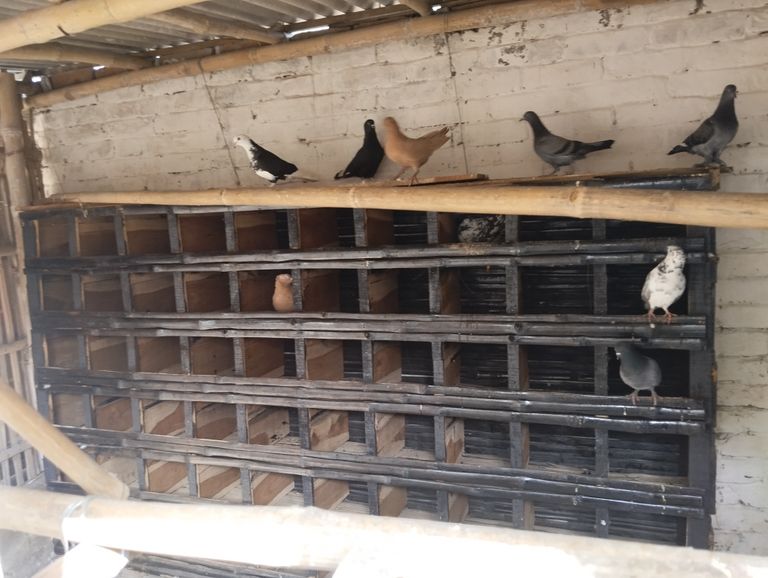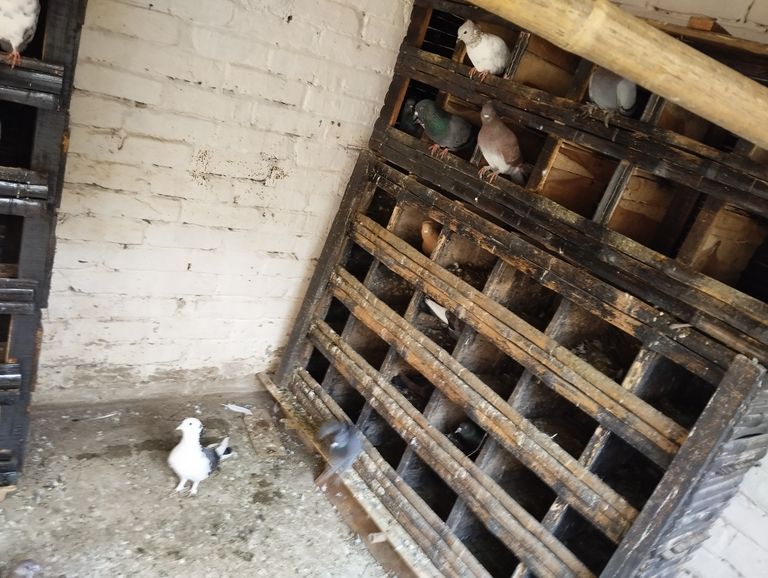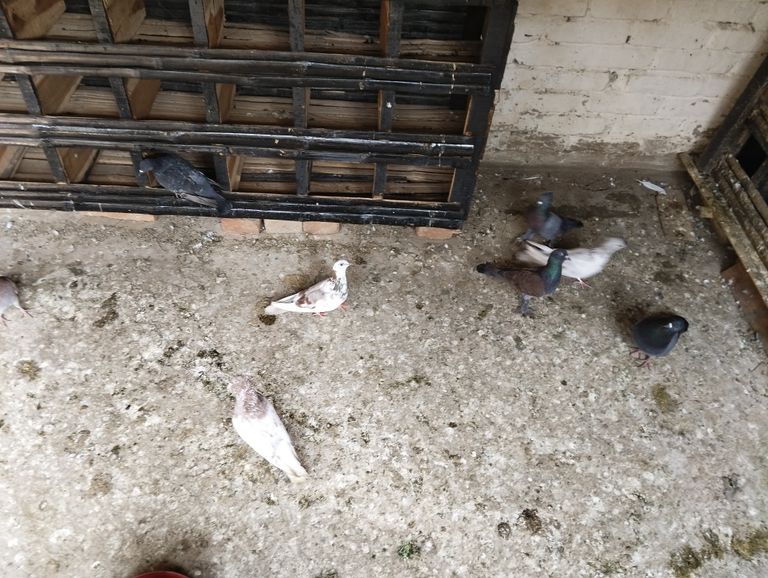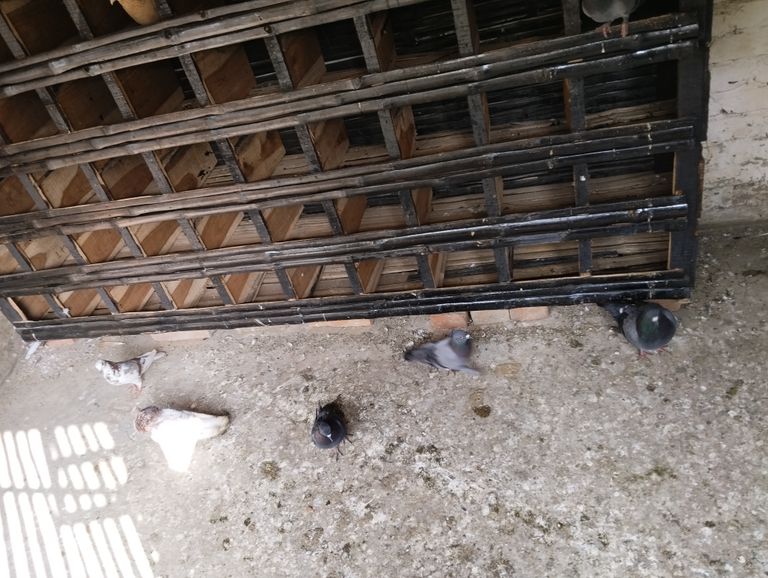Raising Pigeons Indoors A Comprehensive Guide.

Pigeon keeping has been a part of human tradition for centuries. While many enthusiasts raise pigeons in outdoor aviaries, indoor pigeon keeping is gaining popularity, particularly among urban dwellers or those with limited outdoor space. In this article, we’ll explore how to successfully raise pigeons indoors, including their habitat, feeding, health, and tips to ensure they thrive.
Why Raise Pigeons Indoors?
Raising pigeons indoors can be a rewarding hobby. Some of the main reasons for keeping pigeons indoors include:
- Limited Outdoor Space: Urban areas often lack adequate outdoor space for aviaries.
- Protection from Predators: Indoor pigeons are safe from predators like hawks, cats, and raccoons.
- Bonding with Birds: Keeping pigeons indoors allows for closer interaction and stronger bonds with your birds.
- Cleaner Environment: You have better control over their living conditions indoors.
Setting Up the Indoor Habitat
Creating a comfortable and functional environment is key to raising healthy pigeons indoors. Here’s how:
- Cage or Aviary Design
Size: Each pigeon requires about 4-6 square feet of space. For a pair, a cage measuring 4x4x4 feet is ideal.
Ventilation: Proper air circulation is crucial to prevent respiratory issues. Ensure the cage has adequate ventilation without drafts.
Perches and Nesting Areas: Pigeons love to perch. Include wooden or plastic perches and a cozy nesting box for breeding pairs.
- Substrate and Cleaning
Use newspaper, wood shavings, or commercial bird bedding for the cage floor.
Clean the cage at least twice a week to prevent the buildup of droppings and bacteria.
- Lighting
Pigeons need a consistent day-night cycle. Provide 10-12 hours of light daily, either from natural light or artificial bird-friendly bulbs.
Feeding Your Pigeons
A balanced diet is essential for the health of your pigeons.
- Grain Mix
Feed a mix of grains like wheat, millet, peas, and corn. Pigeon feed is also readily available in pet stores.
- Grit
Pigeons require grit to aid digestion. Provide oyster shells or specialized pigeon grit.
- Fresh Water
Always provide clean, fresh water. Use a water bowl that’s easy to clean and prevents contamination.
- Supplements
Calcium and vitamin supplements can be added occasionally to support egg-laying and overall health.
Maintaining Pigeon Health
Healthy pigeons are active, have smooth feathers, and display normal behavior.
- Common Health Issues
Respiratory Diseases: Caused by poor ventilation or dirty environments.
Parasites: Mites and lice can be controlled with bird-safe sprays.
Coccidiosis: Prevent by maintaining cleanliness and providing proper nutrition.
- Vaccination
Pigeons should be vaccinated against common diseases like Newcastle disease. Consult a vet for guidance.
- Quarantine New Birds
Keep new birds separate for 2-3 weeks to ensure they are healthy before introducing them to your flock.
Tips for Raising Happy Indoor Pigeons
- Socialization:
Pigeons are social birds. Spend time with them daily to build trust and prevent loneliness.
- Toys and Enrichment:
Provide toys like hanging ropes, mirrors, or small balls to keep them entertained.
- Regular Health Checks:
Monitor their weight, droppings, and overall behavior for signs of illness.
- Breeding Control:
If you don’t want your pigeons to breed, remove eggs promptly or provide dummy eggs.
- Noise and Activity Levels:
Pigeons are sensitive to loud noises. Place their cage in a quiet area away from high activity.
Challenges of Indoor Pigeon Keeping
While rewarding, raising pigeons indoors does come with challenges:
Space Constraints: Ensure they have enough room to stretch their wings and fly.
Mess: Pigeons can be messy. Invest in tools like cage liners and air purifiers to maintain cleanliness.
Time Commitment: Pigeons require daily care, feeding, and interaction.
Raising pigeons indoors is a fulfilling hobby that can bring joy and companionship. With proper planning, care, and attention, your pigeons can lead healthy, happy lives even in an indoor environment. Whether you're a seasoned pigeon enthusiast or a beginner, this guide provides all the basics to start your journey as an indoor pigeon keeper.

Benefits of Eating Pigeon Meat
Pigeon meat has been consumed as a delicacy in various cultures for centuries. Known for its tenderness and unique flavor, pigeon meat is not only a gourmet treat but also offers several health benefits. This blog explores the nutritional value and advantages of including pigeon meat in your diet.
- High Nutritional Value
Pigeon meat is a rich source of essential nutrients. It contains high-quality protein, which is vital for muscle repair and growth. A 100-gram serving of pigeon meat provides:
Protein: Approximately 25–30 grams of protein, making it an excellent option for bodybuilders and fitness enthusiasts.
Iron: Pigeon meat is a great source of heme iron, which helps prevent anemia by supporting red blood cell production.
Vitamins: It is packed with B vitamins, particularly B6 and B12, which are crucial for brain health and energy production.
- Low in Fat
Unlike other red meats, pigeon meat is low in fat, especially saturated fat. This makes it a heart-healthy choice for individuals looking to maintain a balanced diet without compromising on taste.
- Boosts Immune System
Pigeon meat is rich in zinc, a mineral that plays a key role in boosting immunity. Regular consumption of pigeon meat can enhance the body's ability to fight infections and illnesses.
- Improves Skin and Hair Health
The presence of amino acids, along with zinc and iron, promotes healthier skin and hair. It aids in collagen production, which helps maintain skin elasticity and reduces signs of aging.
- Aids in Recovery and Healing
Pigeon meat is often recommended for individuals recovering from illness or surgery. Its high protein content supports tissue repair, while the nutrients help restore energy levels quickly.
- Supports Cardiovascular Health
The low cholesterol and saturated fat content in pigeon meat contribute to better heart health. Additionally, the presence of omega-3 fatty acids helps reduce inflammation and supports cardiovascular function.
- Energy Booster
Pigeon meat is calorie-dense yet nutritionally balanced, providing a quick energy boost. The B vitamins, along with iron, play a significant role in maintaining energy levels and reducing fatigue.
- Rich in Minerals
Apart from iron and zinc, pigeon meat contains phosphorus and selenium, which are important for bone health and thyroid function, respectively.
- Supports Brain Health
The B vitamins in pigeon meat, particularly B12, enhance cognitive function and prevent memory-related issues. Regular consumption can help improve focus and mental clarity.
- Easy to Digest
Pigeon meat is tender and easy to digest, making it suitable for people with digestive issues or those recovering from illness.
How to Prepare Pigeon Meat
Pigeon meat is versatile and can be prepared in various ways, including roasting, grilling, or stewing. Popular recipes include:
Pigeon Curry: A flavorful dish with spices that enhance the meat’s taste.
Roasted Pigeon: Simple and aromatic, it highlights the natural flavor of the meat.
Pigeon Soup: Perfect for those recovering from illness, as it is light and nourishing.
Precautions
Source: Always source pigeon meat from trusted suppliers to ensure quality and hygiene.
Allergies: While rare, some individuals may be allergic to pigeon meat. Monitor for any adverse reactions.
Portion Control: Although nutritious, consume pigeon meat in moderation as part of a balanced diet.
Pigeon meat is a nutrient-rich delicacy that offers numerous health benefits. From boosting immunity to supporting cardiovascular health, its inclusion in your diet can contribute to overall well-being. However, it is essential to prepare it properly and consume it in moderation to enjoy its full benefits.
If you haven’t tried pigeon meat yet, consider giving it a shot—it’s not just delicious but also a powerhouse of nutrients that can enhance your health.

How to Start a Profitable Pigeon Business
Pigeons have been an integral part of human culture for centuries, admired for their beauty, intelligence, and adaptability. Pigeon farming or pigeon breeding is becoming an increasingly popular business worldwide due to its low investment and high-profit potential. If you’re looking to start a pigeon business, this comprehensive guide will help you get started and ensure profitability.
Why Start a Pigeon Business?
- Low Investment: Pigeons require minimal investment compared to other livestock businesses.
- High Demand: Pigeons are highly valued for their meat (especially in Asian markets), racing, and as pets.
- Quick Breeding: Pigeons breed year-round, ensuring a steady supply.
- Small Space Requirement: You don’t need a large area to start a pigeon farm.
- Multiple Revenue Streams: You can earn from selling pigeons, their eggs, and even pigeon manure as fertilizer.
Types of Pigeons for Business
The type of pigeons you choose depends on your business goals.
- Meat Pigeons: Breeds like King, Carneau, and Mondain are raised for their tender meat.
- Racing Pigeons: These are popular in competitive racing events.
- Show Pigeons: Fancy breeds like Fantails and Jacobins are sold for exhibitions.
- Pet Pigeons: Certain breeds are preferred as household pets due to their calm nature.
Setting Up a Pigeon Farm
- Location and Housing
Choose a quiet, pollution-free location.
Build a pigeon loft or coop that is well-ventilated, dry, and secure.

How to Build a Perfect Pigeon House: A Complete Guide
Pigeons, often called "birds of peace," have been companions to humans for centuries. They are not only a symbol of harmony but also a joy to watch as they flutter around. If you’re considering keeping pigeons as pets or for breeding purposes, building a proper pigeon house is essential. In this blog, we’ll walk you through the steps to build a cozy, safe, and functional home for your pigeons.
Why Build a Pigeon House?
A pigeon house, also known as a loft or dovecote, is more than just a shelter. It provides pigeons with a safe space to rest, breed, and thrive. A well-designed pigeon house ensures:
- Protection from predators and harsh weather.
- Comfort to keep pigeons healthy and stress-free.
- Organization, especially for breeding purposes.
Essential Features of a Pigeon House
Before diving into the construction process, let’s look at the key features your pigeon house should have:
- Adequate Space: Each pigeon requires at least 1-1.5 square feet of space. Overcrowding can lead to stress and diseases.
- Ventilation: Proper airflow is essential to keep the house dry and free of odors.
- Natural Light: Ensure there’s enough light to create a comfortable environment.
- Nesting Boxes: Provide separate sections for nesting, especially if you’re breeding pigeons.
- Easy Access: Design the house so it’s easy for you to clean and for pigeons to move in and out.
Materials You’ll Need
To build a pigeon house, gather the following materials:
Wooden planks or plywood
Mesh wire (for ventilation and protection)
Nails, screws, and a hammer
Hinges (for doors and cleaning panels)
Paint or varnish (for weatherproofing)
Perches (wooden dowels or branches)
Step-by-Step Guide to Build a Pigeon House
Step 1: Choose a Location
Pick a quiet and elevated spot, away from predators like cats and rodents.
Ensure the area is well-lit and free from extreme weather conditions.
Step 2: Design the Structure
Plan for a rectangular or square structure with compartments.
Allocate sections for perches, nesting boxes, and feeding areas.
Step 3: Build the Base
Use wooden planks to create a sturdy base.
Raise the house at least 2-3 feet above the ground to protect against flooding and predators.
Step 4: Create Compartments
Divide the house into individual sections for each pigeon or pair.
Include small entrances for pigeons to enter and exit easily.
Step 5: Add Ventilation
Attach mesh wire panels on the sides or at the back to allow air circulation.
Avoid large gaps that could let predators in.
Step 6: Install Perches and Nesting Boxes
Fix perches inside the house for pigeons to rest.
Install nesting boxes for breeding pairs, ensuring privacy and comfort.
Step 7: Paint and Weatherproof
Apply weatherproof paint or varnish to protect the wood from rain and sunlight.
Use non-toxic paint to ensure the safety of the birds.
Step 8: Final Touches
Install a small door or panel for cleaning and maintenance.
Add a feeding and watering station outside the house.
Tips for Maintaining a Pigeon House
- Regular Cleaning: Clean the house weekly to remove droppings and old nesting material.
- Inspect for Damage: Check for broken parts, gaps, or signs of predators.
- Control Pests: Use safe methods to keep mites, lice, and other pests away.
- Provide Fresh Food and Water: Ensure your pigeons always have access to clean water and quality feed.
- Monitor Health: Watch for signs of illness like lethargy or loss of feathers and consult a vet if needed.
Building a pigeon house is a rewarding project that brings joy and satisfaction to any bird lover. By providing a safe and comfortable home, you’re ensuring the well-being of your pigeons and creating a serene environment where they can thrive.
Start building your pigeon house today and enjoy the beauty and tranquility that these wonderful birds bring.
How to Build a Perfect Pigeon House: A Complete Guide
Pigeons, often called "birds of peace," have been companions to humans for centuries. They are not only a symbol of harmony but also a joy to watch as they flutter around. If you’re considering keeping pigeons as pets or for breeding purposes, building a proper pigeon house is essential. In this blog, we’ll walk you through the steps to build a cozy, safe, and functional home for your pigeons.
Why Build a Pigeon House?
A pigeon house, also known as a loft or dovecote, is more than just a shelter. It provides pigeons with a safe space to rest, breed, and thrive. A well-designed pigeon house ensures:
- Protection from predators and harsh weather.
- Comfort to keep pigeons healthy and stress-free.
- Organization, especially for breeding purposes.
Essential Features of a Pigeon House
Before diving into the construction process, let’s look at the key features your pigeon house should have:
- Adequate Space: Each pigeon requires at least 1-1.5 square feet of space. Overcrowding can lead to stress and diseases.
- Ventilation: Proper airflow is essential to keep the house dry and free of odors.
- Natural Light: Ensure there’s enough light to create a comfortable environment.
- Nesting Boxes: Provide separate sections for nesting, especially if you’re breeding pigeons.
- Easy Access: Design the house so it’s easy for you to clean and for pigeons to move in and out.
Materials You’ll Need
To build a pigeon house, gather the following materials:
Wooden planks or plywood
Mesh wire (for ventilation and protection)
Nails, screws, and a hammer
Hinges (for doors and cleaning panels)
Paint or varnish (for weatherproofing)
Perches (wooden dowels or branches)
Step-by-Step Guide to Build a Pigeon House
Step 1: Choose a Location
Pick a quiet and elevated spot, away from predators like cats and rodents.
Ensure the area is well-lit and free from extreme weather conditions.
Step 2: Design the Structure
Plan for a rectangular or square structure with compartments.
Allocate sections for perches, nesting boxes, and feeding areas.
Step 3: Build the Base
Use wooden planks to create a sturdy base.
Raise the house at least 2-3 feet above the ground to protect against flooding and predators.
Step 4: Create Compartments
Divide the house into individual sections for each pigeon or pair.
Include small entrances for pigeons to enter and exit easily.
Step 5: Add Ventilation
Attach mesh wire panels on the sides or at the back to allow air circulation.
Avoid large gaps that could let predators in.
Step 6: Install Perches and Nesting Boxes
Fix perches inside the house for pigeons to rest.
Install nesting boxes for breeding pairs, ensuring privacy and comfort.
Step 7: Paint and Weatherproof
Apply weatherproof paint or varnish to protect the wood from rain and sunlight.
Use non-toxic paint to ensure the safety of the birds.
Step 8: Final Touches
Install a small door or panel for cleaning and maintenance.
Add a feeding and watering station outside the house.